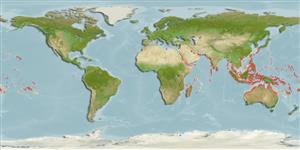Environment: milieu / climate zone / εύρος βάθους / distribution range
Οικολογία
Θαλασσινό(ά); Υφάλμυρο Υφαλόφιλο(α); εύρος βάθους 0 - 5 m (Ref. 9710), usually 0 - 1 m (Ref. 9710). Tropical; 32°N - 32°S
Indo-Pacific: Red Sea and East Africa to the Line, Marquesan, and Tuamoto islands, north to southern Japan, south to Lord Howe and Rapa.
Μέγεθος / Βάρος / Age
Γεννητική Ωρίμανση: Lm ? range ? - ? cm
Max length : 16.0 cm TL αρσενικό/απροσδιόριστο; (Ref. 48636); 13.2 cm SL (female)
Short description
Κλείδες προσδιορισμού | Μορφολογία | Μορφομετρία
Ραχιαίες άκανθες (συνολικά) : 12 - 13; Μαλακές ραχιαίες ακτίνες (συνολικά) : 19 - 21; Εδρικές άκανθες: 2; Μαλακές εδρικές ακτίνες: 21 - 23. Males darkly dusky with 5-6 pairs of bands on body and pale stripes on dorsal fin; develop a crest. Females paler in color, bands broken into spots posteriorly, dorsal fin spotted (Ref. 4404).
Body shape (shape guide): elongated.
Facultative air-breathing (Ref. 126274); Intertidal (Ref. 31184, 48636). Adults are common in areas with large rubble pieces which are often used to built breakwaters or to support jetty-pylons (Ref. 48636). They hide in cracks or holes when not feeding. They jump out of the water in energetic skippings to another pool when pursued (Ref. 2158, 48636). May remain out of water under rocks or seaweeds (Ref. 31184). They breathe air when out of water (Ref. 31184). Feeds on filamentous algae (Ref. 89972). Oviparous. Eggs are demersal and adhesive (Ref. 205), and are attached to the substrate via a filamentous, adhesive pad or pedestal (Ref. 94114). Larvae are planktonic, often found in shallow, coastal waters (Ref. 94114).
Life cycle and mating behavior
Γεννητική Ωρίμανση | Αναπαραγωγή | Γεννοβολία | Αβγά | Γονιμότητα | Προνύμφες
Distinct pairing (Ref. 205).
Springer, V.G. and J.T. Williams, 1994. The Indo-West Pacific blenniid fish genus Istiblennius reappraised: a revision of Istiblennius, Blenniella, and Paralticus, new genus. Smithson. Contrib. Zool. 565:1-193. (Ref. 9962)
IUCN Red List Status (Ref. 130435: Version 2025-1)
Threat to humans
Harmless
Human uses
αλιεία: χωρίς ενδιαφέρον; Ενυδρείο: Εμπορικό(ά)
Εργαλεία
Special reports
Download XML
Διαδικτυακές πηγές
Estimates based on models
Preferred temperature (Αναφ.
123201): 24.7 - 29.3, mean 28.4 °C (based on 2954 cells).
Phylogenetic diversity index (Αναφ.
82804): PD
50 = 0.5001 [Uniqueness, from 0.5 = low to 2.0 = high].
Bayesian length-weight: a=0.00389 (0.00180 - 0.00842), b=3.12 (2.94 - 3.30), in cm total length, based on all LWR estimates for this body shape (Ref.
93245).
Τροφικό Επίπεδο (Αναφ.
69278): 2.0 ±0.00 se; based on food items.
Ελαστικότητα (Αναφ.
120179): Υψηλό, ελάχιστος χρόνος για διπλασιασμό πληθυσμού < 15 μήνες (Preliminary K or Fecundity.).
Fishing Vulnerability (Ref.
59153): Low vulnerability (10 of 100).
🛈
Nutrients (Ref.
124155): Calcium = 119 [53, 207] mg/100g; Iron = 0.718 [0.394, 1.299] mg/100g; Protein = 18.2 [17.0, 19.4] %; Omega3 = 0.0742 [, ] g/100g; Selenium = 19.1 [8.7, 43.6] μg/100g; VitaminA = 94.8 [25.1, 354.5] μg/100g; Zinc = 2.72 [1.76, 4.18] mg/100g (wet weight);
